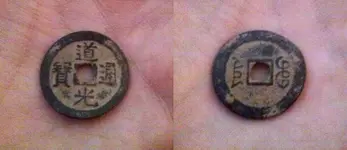TrpnBils
Hero Member
- Joined
- Jan 2, 2005
- Messages
- 870
- Reaction score
- 1,234
- Golden Thread
- 1
- Location
- Western PA
- 🥇 Banner finds
- 1
- 🏆 Honorable Mentions:
- 1
- Detector(s) used
- CTX 3030
- Primary Interest:
- Metal Detecting
Thanks to Don for the initial ID!
An interesting find today in Berkeley County, WV at the site of a home built in the 1790s. It's a Chinese cash coin. From what I've been able to find, the character to the right of the hole on the right-hand picture there shows that it was minted in the Qing dynasty between 1644 and 1911. The character on the right side of the left picture apparently shows that it was minted in Baoding, Zhili Providence, China between 1821 and 1823. This would have been minted during the time when Emperor Xuan Zong was in power and silver was being exported because of the new trade in opium. At that point, coin production was tied to a silver standard and was being devalued because of the export of silver, and these bronze coins cost more to make than what they were worth.
An interesting find today in Berkeley County, WV at the site of a home built in the 1790s. It's a Chinese cash coin. From what I've been able to find, the character to the right of the hole on the right-hand picture there shows that it was minted in the Qing dynasty between 1644 and 1911. The character on the right side of the left picture apparently shows that it was minted in Baoding, Zhili Providence, China between 1821 and 1823. This would have been minted during the time when Emperor Xuan Zong was in power and silver was being exported because of the new trade in opium. At that point, coin production was tied to a silver standard and was being devalued because of the export of silver, and these bronze coins cost more to make than what they were worth.
Attachments
Upvote
7



